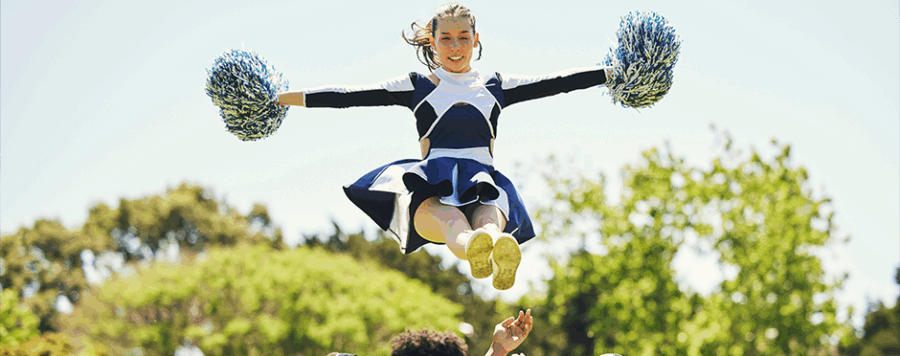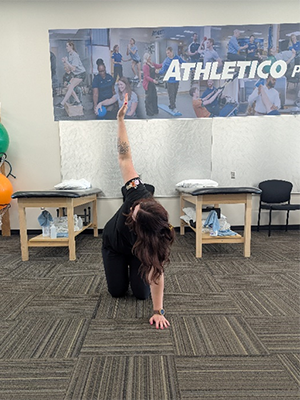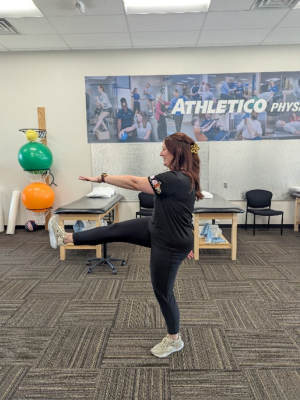Flyers are the athletes in the air performing stunts, and the bases are the athletes helping to hold them up, spot, and catch them after a toss. Proper stretching is recommended for all athletes to prevent injuries. Due to their roles on the team, different stretches are recommended for flyers versus bases.
When Do Injuries for Cheerleaders Occur1, 2
- Injuries occur more frequently during practice for cheerleaders
- Higher rates of injury during stunting
- Bases appear to be more frequently injured
Types of Cheer Injuries1, 2
- The most common injuries for cheerleaders are lower extremity injuries
- The most common types of injuries include ligament sprains and muscle strains
- Younger athletes (6–11-year-olds) are more likely to experience an upper extremity injury, and older cheerleaders (12–17-year-olds) are more likely to experience a lower extremity injury
- Concussions and other head injuries only account for 4-6% of all cheerleading injuries
Dynamic vs Static Stretching
Dynamic stretching is “active stretching”, when a limb is moved through the range of motion to the end ranges and is repeated several times. It is ideal prior to workouts or competitions to warm up the muscles and prepare for the activity ahead.
Static stretching is when a position is held with the muscle on tension; static stretches are held for longer lengths of time, such as 20-30 seconds. It has been shown to help with overall flexibility and is ideal for a cool down or at the end of a workout.
Dynamic Stretches for Cheer Bases
Common areas for injury for cheer bases are the low back and wrists because bases perform stunts where they lift and support other athletes over their heads. Proper stretching should target the back, legs, and wrists to prepare for those activities.
Low back: A dynamic warm-up for the lower back includes roll-downs and roll-ups, as well as trunk rotations. Threading the needle is another good warm-up for the back and arms.
Threading the Needle
Quadriceps stretches: Examples of dynamic stretches for the quads are heel grabs behind your back. You can walk a lap while performing this movement. Squats and lunges are also a good warm-ups for the quads and legs for cheer bases.
Wrist stretches: Wrist rolls in both directions can help warm up the wrists. You can go on all-4’s and shift forward and backward as well as side to side to prepare the wrist for weight bearing.
Dynamic Stretches for Cheer Flyers
Common areas for injury for cheer flyers include the lower back, ankle, and hamstrings. Flyers often perform holds and twists in the air during stunts, and they need to be very flexible to perform those skills. Proper warm-up and stretching for the back and legs should be performed prior to practice or competition, as well as stretching at the end of practice.
Low back stretch: Similar to bases, flyers can also warm up their backs with roll-down and roll-ups, and trunk rotations. Threading the needle or cat-cow are also good stretches for flyers.
Hamstring stretches: Dynamic hamstring stretches, zombie kicks or 3-way leg kicks/swings (forward/backward and side to side). You can also do heel scoops, where you have one leg forward with the toes up toward the ceiling and bend forward to scoop the arms down near the floor.
Zombie Kicks
Ankle stretches: Dynamic ankle stretches include ankle rolls, heel, and toe raises. When going up onto your toes, try to make sure you don’t let your ankles roll in or out. Downward dog stretches can also help warm up the ankles.
Proper warm-ups, including dynamic stretching, and cool-downs, including static stretching, can help cheerleaders prevent injuries and stay on the mat, court, or field all season long. Schedule a free assessment at your local Athletico to learn more!
*Per federal guidelines, beneficiaries of plans such as Medicare, Medicaid, Tricare, VHA and other federally funded plans are not eligible for free assessments.
The Athletico blog is an educational resource written by Athletico employees. Athletico bloggers are licensed professionals who abide by the code of ethics outlined by their respective professional associations. The content published in blog posts represents the opinion of the individual author based on their expertise and experience. The content provided in this blog is for informational purposes only, does not constitute medical advice and should not be relied on for making personal health decisions.
References:
1. Shields BJ, Smith GA. Cheerleading-related injuries in the United States: a prospective surveillance study. J Athl Train. 2009;44(6):567-577. doi:10.4085/1062-6050-44.6.567
2. COUNCIL ON SPORTS MEDICINE AND FITNESS, Labella CR, Mjaanes J, et al. Cheerleading injuries: epidemiology and recommendations for prevention. Pediatrics. 2012;130(5):966-971.
3. Page P. CURRENT CONCEPTS IN MUSCLE STRETCHING FOR EXERCISE AND REHABILITATION. International Journal of Sports Physical Therapy. 2012;7(1):109-119.
About the Author:
Tara Hackney, a physical therapist in Marion, IA, enjoys working with all patient types, especially gymnasts, cheerleaders, and dancers. She is the prominent blogger for Athletico's Gymnastic/Cheer Program. With an orthopedic specialization and training in dry needling and Graston technique, Tara hopes to answer your questions about injuries and injury prevention in an easy-to-understand manner. She hopes to ease fears surrounding pain and injuries, address concerns about recovery, and provide tips to prevent injury. In her free time, she enjoys spending time with her dog, reading, and watching her nephews play sports.

 width="900"
height="356"
>
width="900"
height="356"
>



